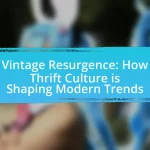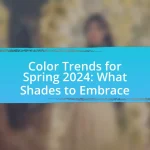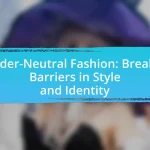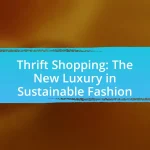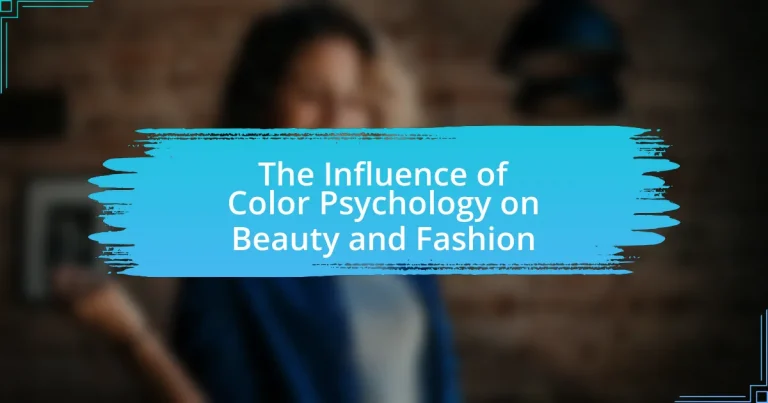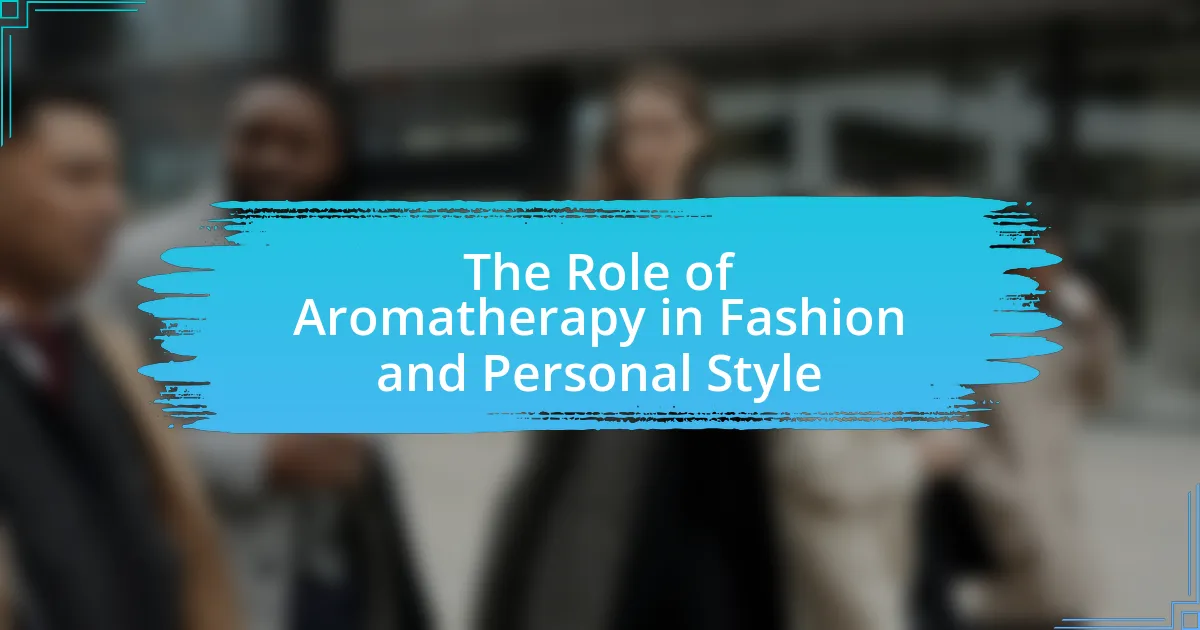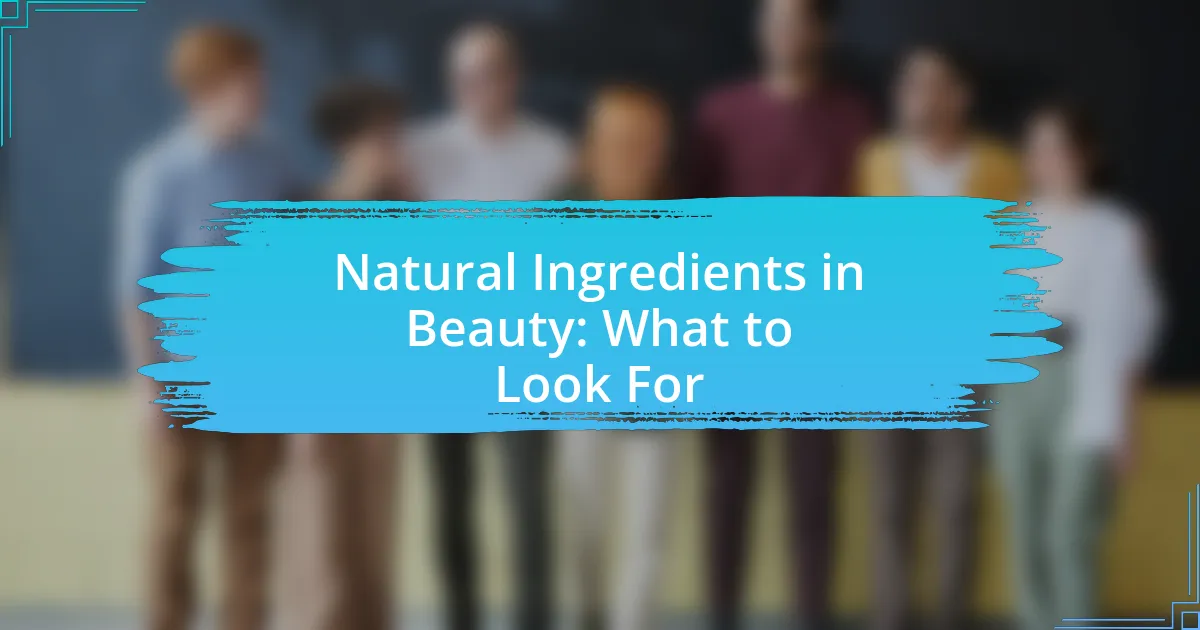The article examines the influence of color psychology on the beauty and fashion industries, highlighting how colors affect consumer perceptions, emotions, and purchasing decisions. It discusses the psychological effects of various colors, such as red’s association with passion and blue’s connection to trust, and how brands strategically utilize these colors in their marketing strategies to enhance brand identity and recognition. Additionally, the article explores the historical evolution of color preferences, cultural factors influencing color choices, and practical tips for consumers to apply color psychology in their beauty and fashion selections. Overall, it underscores the critical role of color in shaping trends and consumer behavior within these sectors.
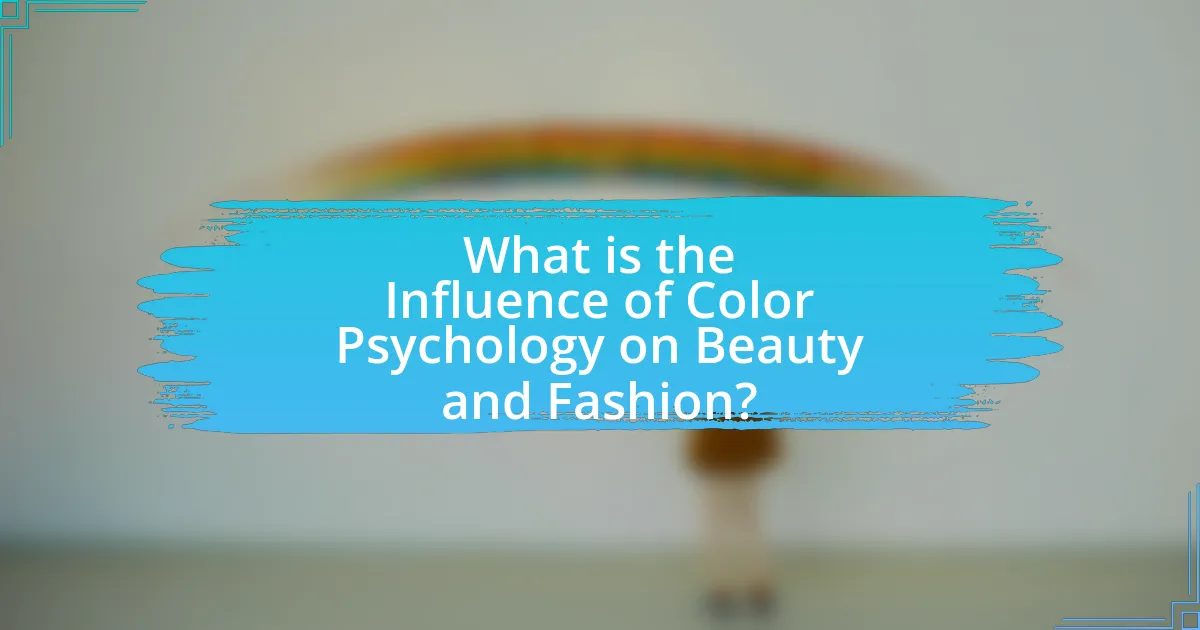
What is the Influence of Color Psychology on Beauty and Fashion?
Color psychology significantly influences beauty and fashion by affecting consumer perceptions and emotional responses. For instance, colors like red are often associated with passion and excitement, leading to increased attention and desire for beauty products or fashion items in that hue. Research indicates that 85% of consumers make purchasing decisions based on color, highlighting its critical role in marketing strategies within the beauty and fashion industries. Additionally, brands utilize color to convey specific messages; for example, blue is linked to trust and reliability, making it a popular choice for brands aiming to establish credibility. This strategic use of color not only enhances brand identity but also shapes consumer behavior and trends in beauty and fashion.
How does color psychology impact consumer behavior in beauty and fashion?
Color psychology significantly impacts consumer behavior in beauty and fashion by influencing emotions, perceptions, and purchasing decisions. For instance, studies show that colors like red can evoke feelings of excitement and urgency, often leading to impulse purchases, while blue is associated with trust and calmness, making it effective for brands aiming to establish reliability. Research conducted by the Institute for Color Research indicates that up to 90% of snap judgments made about products can be based on color alone, highlighting its critical role in attracting consumers and shaping their preferences in the beauty and fashion industries.
What are the psychological effects of different colors on emotions and perceptions?
Different colors have distinct psychological effects on emotions and perceptions. For instance, red often evokes feelings of passion and urgency, while blue tends to promote calmness and trust. Research indicates that yellow can stimulate feelings of happiness and energy, whereas green is associated with tranquility and health. A study published in the journal “Color Research and Application” by Andrew J. Elliot and Markus A. Maier found that colors can significantly influence mood and behavior, demonstrating that warm colors like red and orange can increase arousal, while cool colors like blue and green can have a calming effect. These associations are utilized in beauty and fashion to evoke specific emotional responses and influence consumer behavior.
How do brands utilize color psychology in their marketing strategies?
Brands utilize color psychology in their marketing strategies by selecting specific colors that evoke desired emotions and associations in consumers. For instance, the color red is often used to create a sense of urgency and excitement, which can drive impulse purchases, while blue is frequently associated with trust and reliability, making it a popular choice for brands aiming to establish credibility. Research indicates that up to 90% of snap judgments made about products can be based on color alone, highlighting its significant impact on consumer behavior. Additionally, brands like Coca-Cola and Tiffany & Co. have effectively leveraged their signature colors—red and robin’s egg blue, respectively—to create strong brand identities that resonate emotionally with their target audiences.
Why is color selection crucial in beauty and fashion industries?
Color selection is crucial in the beauty and fashion industries because it directly influences consumer perception and emotional response. Colors evoke specific feelings and associations; for instance, red is often linked to passion and excitement, while blue conveys calmness and trust. Research indicates that up to 90% of snap judgments made about products can be based on color alone, highlighting its significant role in attracting customers and driving purchasing decisions. Additionally, brands utilize color to establish identity and differentiate themselves in a competitive market, as seen with iconic brands like Tiffany & Co., whose trademarked robin’s egg blue is instantly recognizable and associated with luxury.
What role does color play in brand identity and recognition?
Color plays a crucial role in brand identity and recognition by influencing consumer perceptions and emotions. Brands utilize specific colors to evoke desired feelings and associations, which can enhance brand recall and loyalty. For instance, research by the Institute for Color Research indicates that color can increase brand recognition by up to 80%. Additionally, colors are often linked to particular traits; for example, blue conveys trust and dependability, while red evokes excitement and urgency. This strategic use of color helps brands differentiate themselves in a competitive market, making it easier for consumers to identify and connect with them.
How does color influence trends in beauty and fashion?
Color significantly influences trends in beauty and fashion by evoking emotions and shaping consumer perceptions. For instance, specific colors are associated with particular feelings; blue often conveys calmness, while red can signify passion. This psychological impact drives brands to select colors that resonate with their target audience, ultimately affecting purchasing decisions. Research by the Institute for Color Research indicates that color increases brand recognition by up to 80%, highlighting its importance in marketing strategies within the beauty and fashion industries. Additionally, seasonal color trends, such as Pantone’s Color of the Year, guide designers and consumers alike, reinforcing the cyclical nature of color influence in these sectors.
What are the historical perspectives on color psychology in beauty and fashion?
Historical perspectives on color psychology in beauty and fashion reveal that color has been used symbolically and psychologically across various cultures and eras to convey messages and influence perceptions. For instance, in ancient Egypt, colors like green symbolized fertility and rebirth, while red was associated with chaos and disorder. In the 18th century, the use of color in fashion became more pronounced, with the emergence of color theory by artists like Johann Wolfgang von Goethe, who emphasized the emotional impact of colors. The 20th century saw the rise of psychological studies, such as those by Faber Birren, who explored how colors affect mood and behavior, influencing fashion trends and beauty standards. These historical insights illustrate that color psychology has consistently played a crucial role in shaping beauty and fashion, guiding choices and preferences throughout time.
How have color preferences evolved over time in these industries?
Color preferences in the beauty and fashion industries have evolved significantly over time, reflecting cultural shifts, technological advancements, and changing consumer attitudes. For instance, in the early 20th century, muted and pastel colors dominated fashion, aligning with the conservative values of the time. However, the 1960s introduced vibrant colors and bold patterns, influenced by the counterculture movement and a desire for self-expression.
In recent years, data from the Pantone Color Institute indicates a trend towards earth tones and natural hues, driven by a growing emphasis on sustainability and wellness. This shift is evident in the popularity of colors like terracotta and sage green, which resonate with consumers’ desire for authenticity and connection to nature. Additionally, the rise of social media has accelerated the speed at which color trends emerge and fade, as influencers and brands quickly adapt to consumer preferences.
Overall, the evolution of color preferences in these industries illustrates a dynamic interplay between societal values and individual expression, with historical context providing insight into current trends.
What cultural factors influence color choices in beauty and fashion?
Cultural factors such as traditions, symbolism, and social norms significantly influence color choices in beauty and fashion. For instance, in many Asian cultures, red symbolizes good fortune and is often worn during celebrations, while in Western cultures, black is commonly associated with elegance and mourning. Additionally, cultural heritage can dictate color preferences; for example, vibrant colors are favored in African fashion, reflecting cultural identity and community ties. Historical context also plays a role; the use of specific colors can be traced back to significant events or movements, such as the suffragette movement in the early 20th century, where white, purple, and green were used to symbolize women’s rights. These cultural influences shape consumer behavior and preferences in the beauty and fashion industries, demonstrating the profound impact of cultural context on color selection.
How does color psychology affect product design in beauty and fashion?
Color psychology significantly influences product design in beauty and fashion by shaping consumer perceptions and emotional responses. For instance, colors like red evoke feelings of passion and excitement, often used in beauty products to attract attention, while blue conveys trust and calmness, making it popular in skincare branding. Research indicates that 85% of consumers make purchasing decisions based on color, highlighting its critical role in marketing strategies. Additionally, studies show that colors can affect mood and behavior; for example, yellow is associated with optimism and energy, which can enhance the appeal of fashion items. Thus, understanding color psychology allows brands to create products that resonate emotionally with their target audience, ultimately driving sales and brand loyalty.
What specific colors are associated with particular beauty and fashion products?
Red is commonly associated with boldness and passion in beauty and fashion products, often seen in lipsticks and dresses. Pink signifies femininity and romance, frequently used in cosmetics and casual wear. Black represents elegance and sophistication, prevalent in luxury fashion items and formal wear. Blue conveys calmness and trust, often found in skincare packaging and casual clothing. Green symbolizes freshness and health, commonly used in organic beauty products and eco-friendly fashion. Yellow evokes happiness and energy, often seen in summer collections and vibrant accessories. Each color’s association is rooted in psychological effects and cultural perceptions, influencing consumer choices in the beauty and fashion industries.
How do different colors enhance the appeal of cosmetics and clothing?
Different colors enhance the appeal of cosmetics and clothing by influencing perceptions, emotions, and consumer behavior. For instance, warm colors like red and orange are often associated with energy and passion, making them attractive choices for cosmetics that aim to create a bold statement. In clothing, these colors can evoke feelings of warmth and excitement, drawing attention to the wearer. Conversely, cool colors such as blue and green are linked to calmness and tranquility, making them appealing for cosmetics that promote a natural or soothing look. Research indicates that color can affect purchasing decisions; a study published in the Journal of Business Research found that up to 90% of snap judgments made about products can be based on color alone. This demonstrates that the strategic use of color in cosmetics and clothing not only enhances aesthetic appeal but also significantly impacts consumer attraction and engagement.
What are the implications of color choices for product packaging?
Color choices for product packaging significantly influence consumer perception and purchasing behavior. Research indicates that up to 90% of snap judgments made about products can be based on color alone, highlighting its critical role in brand identity and market differentiation. For instance, colors evoke specific emotions and associations; blue often conveys trust and reliability, while red can stimulate excitement and urgency. This emotional response can directly impact sales, as brands that align their packaging colors with consumer expectations and psychological triggers tend to perform better in competitive markets. Additionally, color choices can affect brand recognition, with consistent use of color leading to a 80% increase in brand recognition, according to studies by the University of Loyola, Maryland. Thus, strategic color selection in packaging is essential for effective marketing in the beauty and fashion industries.
What practical tips can consumers use to apply color psychology in their beauty and fashion choices?
Consumers can apply color psychology in their beauty and fashion choices by selecting colors that evoke desired emotions and perceptions. For instance, wearing red can convey confidence and attract attention, while blue is often associated with calmness and trustworthiness. Research indicates that colors can influence mood and behavior; for example, a study published in the Journal of Experimental Psychology found that warm colors like red and yellow can increase energy levels, while cool colors like blue and green can promote relaxation. Therefore, consumers should consider the psychological effects of colors when choosing clothing or makeup to align their appearance with their intended message or emotional state.
